Thoughts abound, but time is scarce. No classes today, but plenty of work: email, upcoming conferences, journals to read. Probably no blogging. Meanwhile, having me at home makes the cat frisky.
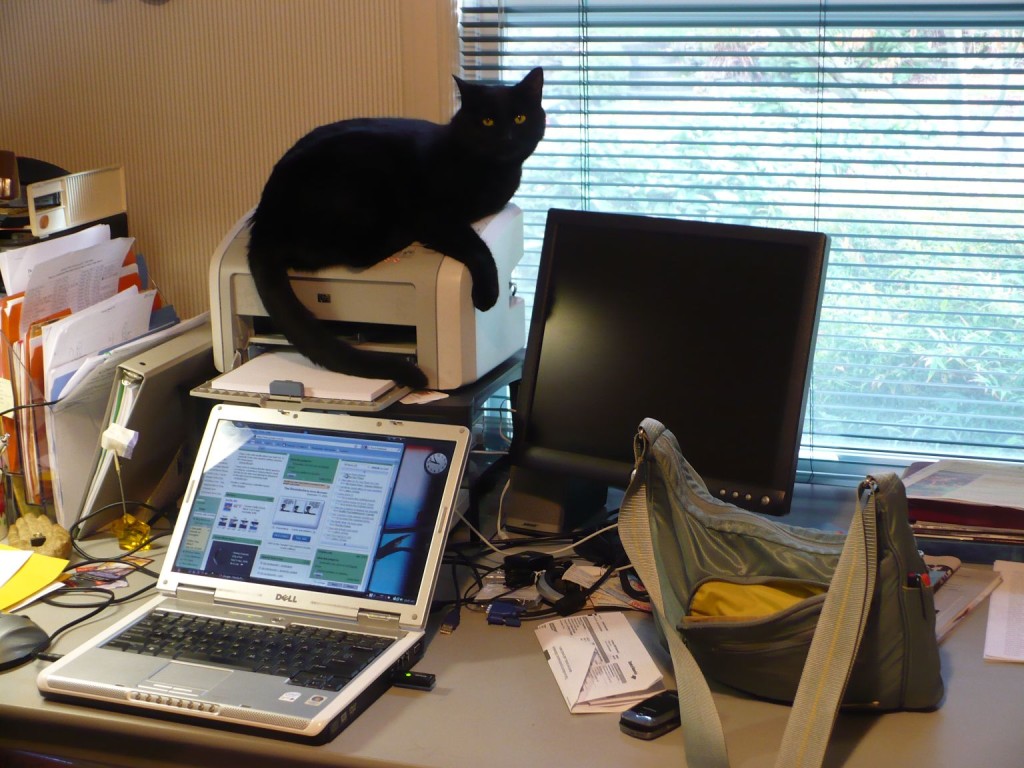
We'll negotiate if I have to print.

Thoughts abound, but time is scarce. No classes today, but plenty of work: email, upcoming conferences, journals to read. Probably no blogging. Meanwhile, having me at home makes the cat frisky.

We'll negotiate if I have to print.
Here’s a good excuse for a smile, no matter what else is going on…
via Corey Mahoney, most recently
With an expanded student population this year, my schedule is pretty crazy — 40 classes per week with 5 different plans per day. Also new is that I serve two self-contained classes of autistic students. Given no previous experience with autism, I’m reading up on it, but I’m also doing a fair amount of learning-on-the-run, as our 30-minute classes together come around every afternoon.
I have 2 groups which are distinctly different, and as I’ve gotten to know them, I’ve learned a lot. The older group (labeled as 1st-3rd graders, which indicates both age and a certain amount of time in school) has 9 students. They have a very experienced teacher, with 2 instructional assistants who have been working together as a team (with these children) for awhile. There are moments of chaos anytime something new is introduced, but using experimentation, intuition & some helpful hints from their teachers, I’ve introduced a number of activities with this group. Individual students come & go with their focus, but all of them are following along at least a percentage of the time. Here are some activities with which we’ve made some progress:
~~Clapping conversations: These are one-on-one, your turn/my turn sound conversations, between myself & one child. I’m pretty explicit, saying & pointing “my turn” & “your turn.” Sometimes one of the aids helps a student pause & “listen,” but they’re all glad to give me a high-five at the end. We’ve done a few variations — no more than one per day: hand clapping; hand clapping & knee slapping; I start, they answer; they start, I echo; clapping with 1′ lengths of swim noodles…
~~BrainDance: I go through the various body organizations of the BrainDance, over a period of 8-10 minutes. For each section, I repeat the same moves for quite awhile, with slight variations, cause they don’t all respond immediately. I tend to use a prop (a scarf or a stretchy band). The scarf is particularly good for breathing (it’s light enough to blow away), tactile (soft touches like brushing & tickling), & core-distal (their bodies do stretch & scrunch with the scarf) — and works fine for upper/lower, right/left, cross-lateral & vestibular. The stretchy band is especially good for tactile (using it to rub the back like a towel), core/distal & body half (R/L). The head/tail/spine connection is still evading us completely — heads move but torsos don’t.
~~Once we’ve got a prop for the BrainDance, we continue with a pause dance, progressing gradually from a basic start-stop format to responding to various musical qualities (e.g. slow & fast). I now have a playlist of musical selections that pause.
~~Shoemaker Dance: Alternating the gesture phrase (“wind the bobbin, wind the bobbin, wind the other way, pull, pull & tap, tap tap”) with locomotor sections gives them a steady dose of locomotor moves to try. Each of them has a different array of moves they can or can’t do. It provides a good structure for cycling through a “bear walk” (a body half, right/left crawl on hands & feet), the alligator (a crawl on the belly), and other developmental moves.
~~A pathway of plastic spots for traveling on started as a short circle, but has grown pretty long now, extending across the room, with hula hoops in stands at beginning and end. The hula hoops were a real challenge… for several of the children, I had to bring it down gently over their head the first time & having them step out, in order for them to understand “going through.” Now they’re all able to bend & slip through. I also alternate the colors of spots, because one boy has longer legs & can aim for every other spot. They each have their own way of traveling the path: hopping, crawling, jumping, walking… but they all follow it. I had to create a written, rotation system for who goes first, second, third… after the issue of “first” caused a noisy tantrum one day.
~~Parachute activities still have a long way to go, but the kids seem to like the parachute. Again, it was total chaos the first few days, but we’re working on 3 structures so far… 1. Everyone holds, and we raise & lower on cue; 2. Everyone raises & lowers, while one person at a time goes underneath (under on the first lift, out on the second); 3. Everyone holds, and we try to keep a large nerf ball on the parachute.
I’m so grateful for the instructional assistants who come with this group — they know the kids and help a different one each day. So far, we’re working on whole body organization & locomotor moves, following cues in the music, taking turns & working together. The students seem to like being in my space with me, while I change & add things slowly.
My other group is quite a different story. As “kindergarteners” (again a label referring to a combination of age & (lack of) school experience), the children are completely non-verbal and don’t respond to pictures yet either. Their teacher is working very hard, but the two instructional assistant positions for her group have been filled by an erratic sequence of substitutes with no experience. I’ve given up having them come to my space because it has 4 doors, too many light switches, curtains for hiding in, and too much equipment that can’t be secured. I think the classroom is being considered for a different classification, with a higher adult/student ratio, but in the meantime, I visit them in the classroom and am still struggling to find activities that work….
This week the same instructional assistants were with us all week, and I did the same lesson every day:
Repetition & routine seem to be key! For now, I’m satisfied that they’re with me at all. Eventually, I hope progress will be apparent….
When two autism classes were added to my schedule this year, I was grateful to make contact via Anne Green Gilbert with other dance educators who work with special needs & autistic children. Thusfar, this small support group of colleagues communicates somewhat erratically by email, but what a relief it is to hear from others! I really appreciate the support of their ideas and perspectives. Following is a glimpse into the world of Pat Parker, a dance educator in Burnaby, BC, Canada. She provides a developmental movement program for special needs students, many of whom are autistic. Today my own order of beach balls arrived, and I’m hoping my kids will be able to get them blown up next week. Whether they can or not, we’ll find ways to work…
Beach balls & basic skills for kids with special needs
by Pat Parker
Things have been going well with the developmental movement group. Beachballs have proven a great success. The kids love them and want them everyday. So now they are a great motivator. They are all progressing in their ability to blow them up and manage the fine motor task of putting the stopper in place. They have all improved in their ability to inhale and exhale deep breaths, and I see the calming effects of deep breathing when we need it! It also helps bring them together as a group and get focused on me when we breathe together – I call it “beachball bellies.” So the idea of using the beachballs to help develop the breath pattern seems to have worked.
After we blow up the balls, there are secondary benefits in the beach ball play, which develops eye focus and tracking. This is a big issue for most of the autistic kids in particular, since they have a hard time maintaining eye focus. The play is also interactive, with socializing the results of playing catch with their aids and with each other. …it teaches give and take – shared interaction – it’s hard work for the lower functioning children and joyful for those on a higher level – but all in a safe and non-competitive situation which is not always the case in a PE class.
It has taken about ten session with the beachballs to see this progress. My general plan is to work each day on a complete BrainDance including all the patterns and spend several weeks focusing on each pattern in some way. The beachballs were the strategy for focusing on breath.
I have a ball for each child – with their name on it — the same ball each time so I don’t have to keep sterilizing them. We have hand sanitizer for the aides to use after helping the kids with blowing. I also have a couple of balls blown up ready to use for any kids that can’t get their ball completely inflated. I want them to be able to play even if they can’t quite blow the ball up all the way. Most of my guys ( my group is all boys) can do it now.
At the end (after a one minute warning to smooth the transition), we sit together and squeeze the air out of the balls… feeling it blow on our faces, and say good bye.
Repetition, pattern, and routine are really important. So far so good but each day presents its challenges.
Last Tuesday, my fifth graders clicked into flow, despite the frantic limitations of this year’s 30-minute classes, and it crossed my mind that I might survive. Cause flow is why I teach & what keeps me going. Flow is the mental state of operation in which the person is fully immersed in what he or she is doing by a feeling of energized focus, full involvement, and success in the process of the activity — that’s flow a la Mihály Csíkszentmihályi. In my class, it’s a state in which the kids are fully engaged in creating dance or working on dancing — without my involvement. It takes some finagling to get them there though, because the task they’re working on has to be understandable, challenging, doable, and on the edge of their skill level.
When you arrive there, there’s a kind of happy hum in the room. It’s noisy & busy, with groups of kids planning, trying, talking, crisscrossing through each other — or if they’re working solo, they’re concentrating, changing, showing & comparing. And after some minutes of the hum — 5? 10? — they’re back in touch with me: “Can I show you?” “You want to see?” “Come & look!”
But it’s fragile too — the edges of it can crack quickly if two students bump… if one member of a group isn’t heard… if a new student doesn’t get it… if another can’t handle freedom…
It takes more than 30 minutes to set up. Last Tuesday was the culmination of 4 days of work, building the focus. They’d been researching Land & Water in science, so in dance class we…
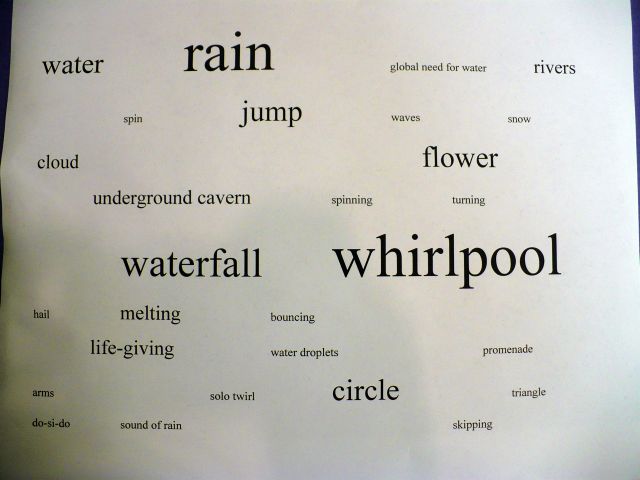
Word cloud of ideas
When we got to the draft-a-dance stage, they began to hum. Lots of movement, no arguments, talking in their small groups, trying out formations, swirling together, changing levels…
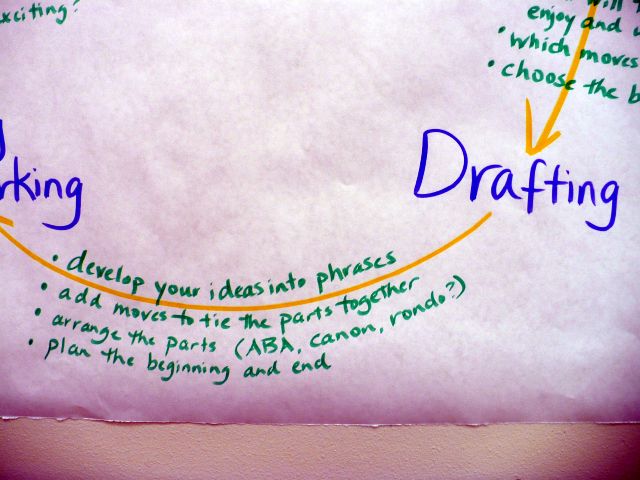
drafting the dance
On Wednesday, several groups continued in flow, while several broke up: Melinda who’s new this year wanted to do cartwheels, but her group didn’t think they fit the mood; Jeremy who’d been his group’s leader on Tuesday was absent on in-school suspension; and Oscar, returning from an absence, didn’t get it.
Thursday was better, as they refined their work & performed for each other — better enough that they rehearsed as whole group and will perform tomorrow. A great performance? Probably not, since it’s only their first for the year. But the performance wasn’t the goal — the flow (engaged, energized creativity) was.
And hopefully, flow will reappear as we redo this process throughout the year…
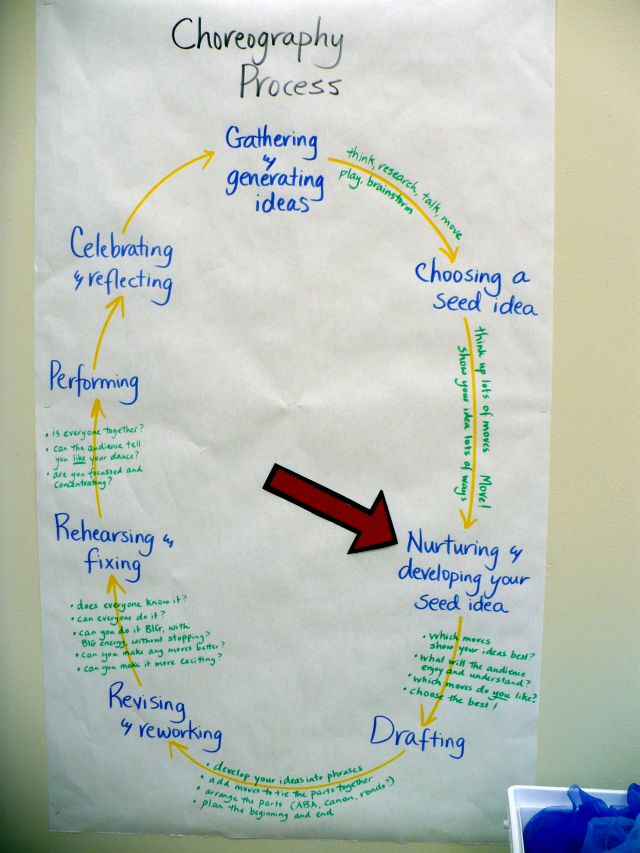
the choreographic process
Early, early dance ed…
Via Maya Soto
Comments Off
Grades: 1st-5th grades
Teaching points: The dance classroom has standards: Make good decisions. Show respect. Solve problems. [These are school-wide standards.]
Targets:
Context: Just now it’s no longer the first week of school, but the first week of school comes along every year, so let’s pretend we’re back there & get it down. At the beginning, there are some necessary basics that have to be covered: clothing requirements, safety issues, fire & earthquake drills & expectations.
Lesson 1 : Dancers make good decisions, with safety first.
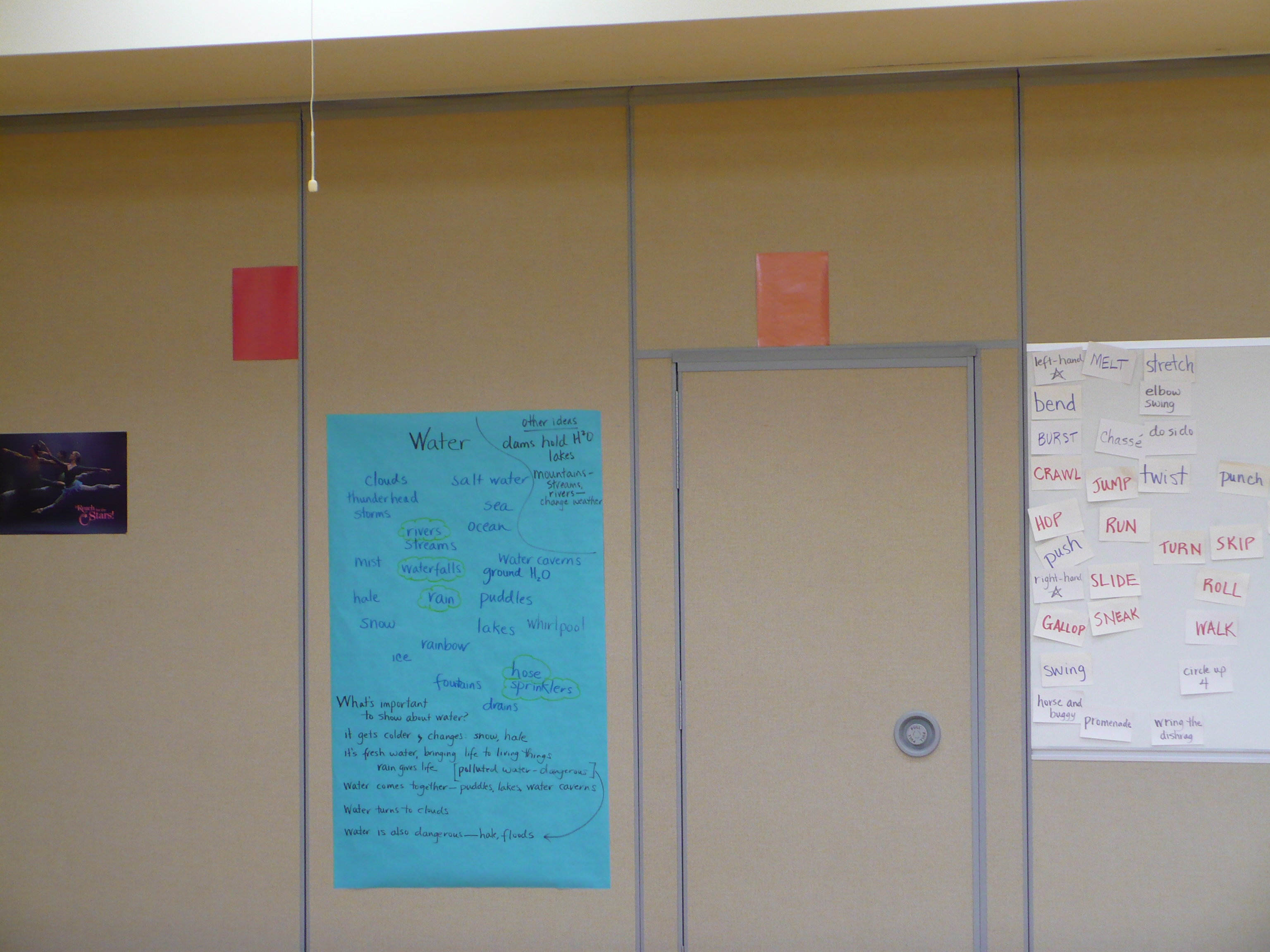
Red & orange rectangles mark the north ends of 2 invisible lines
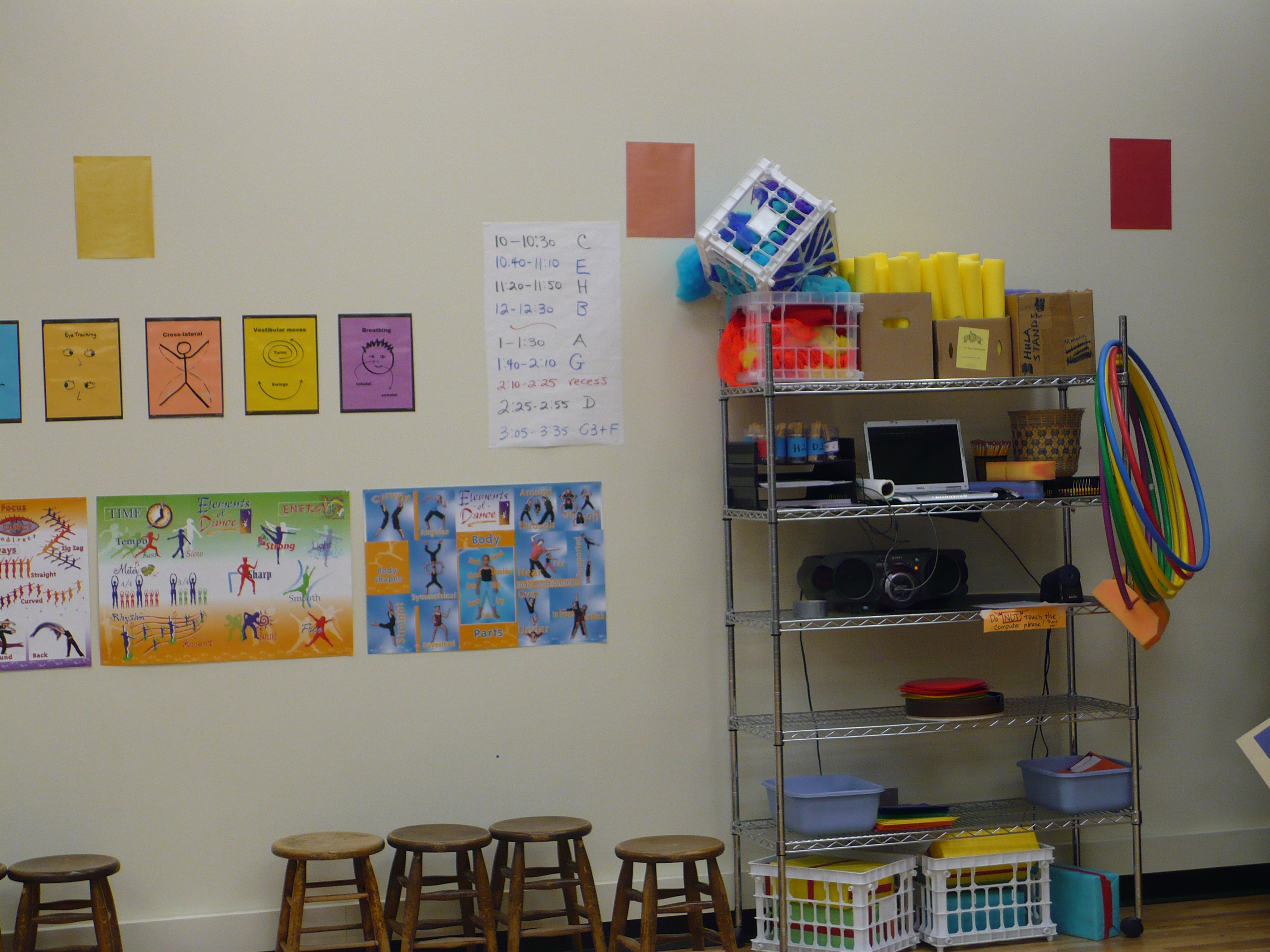
Red, orange & yellow rectangles mark the opposite ends of invisible lines
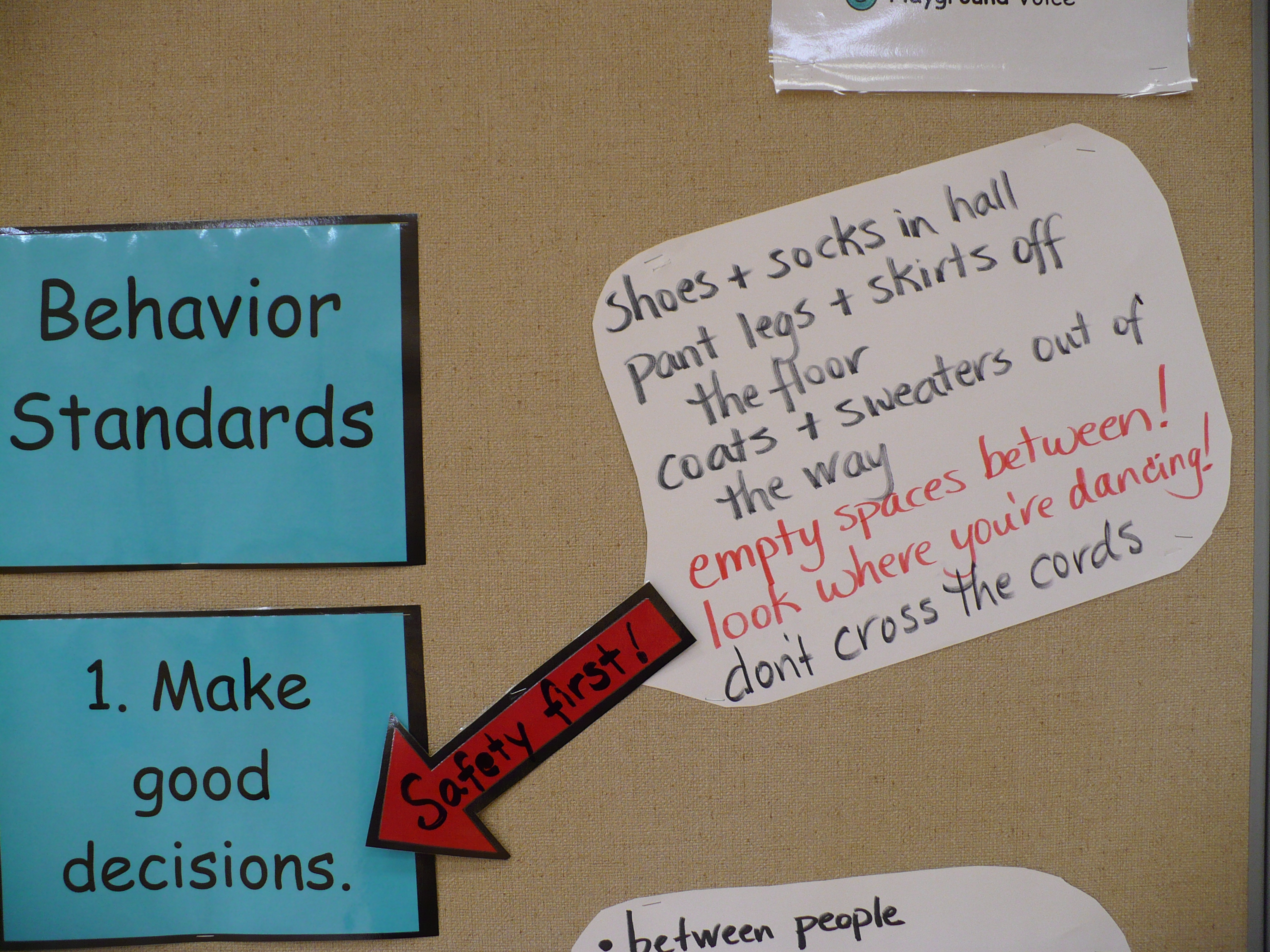
Details for "Make good decisions"
Lesson 2: Dancers show respect, verbally & non-verbally.
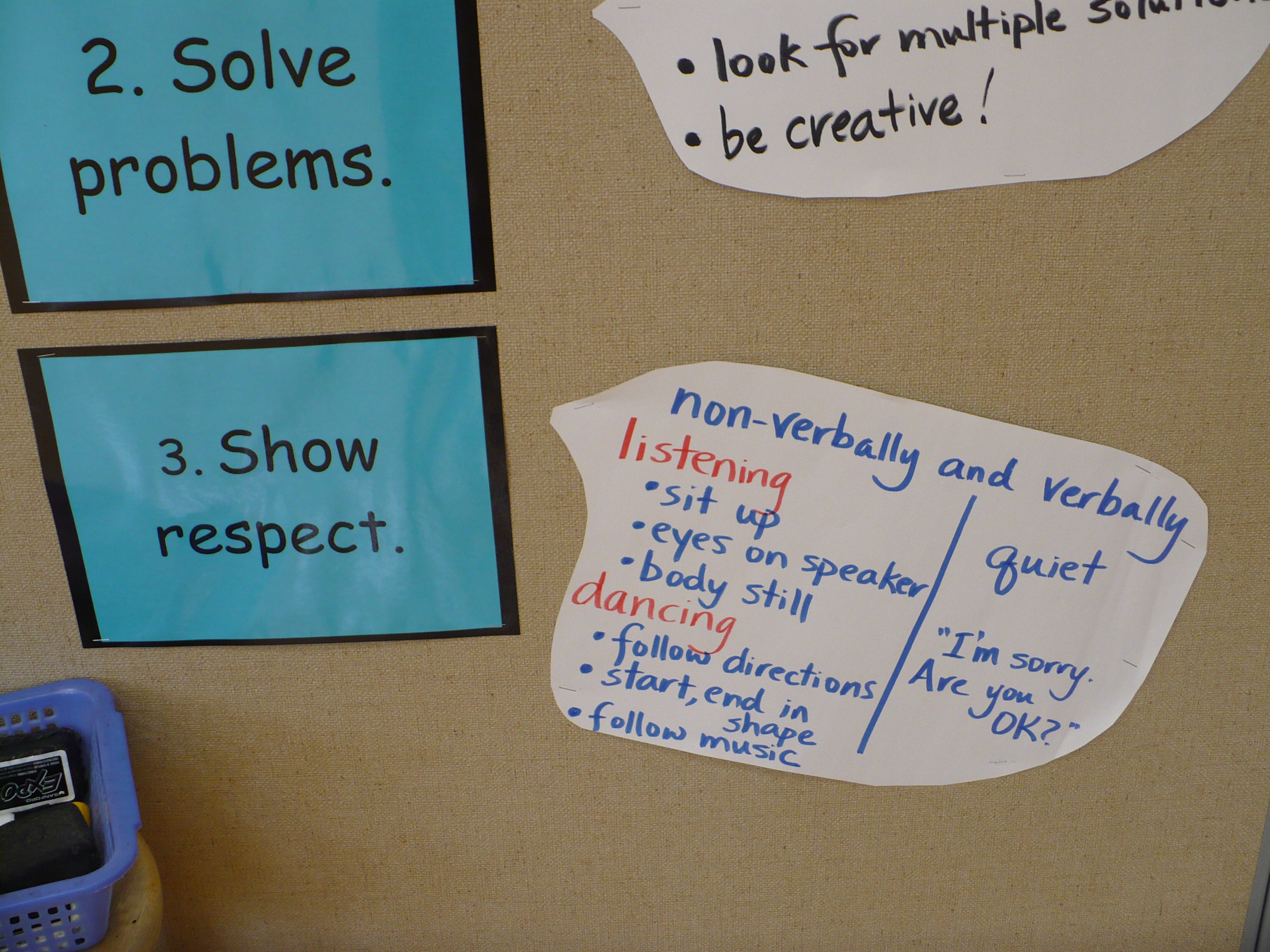
Details for "Show Respect"
Lesson 3: Dancers solve problems.
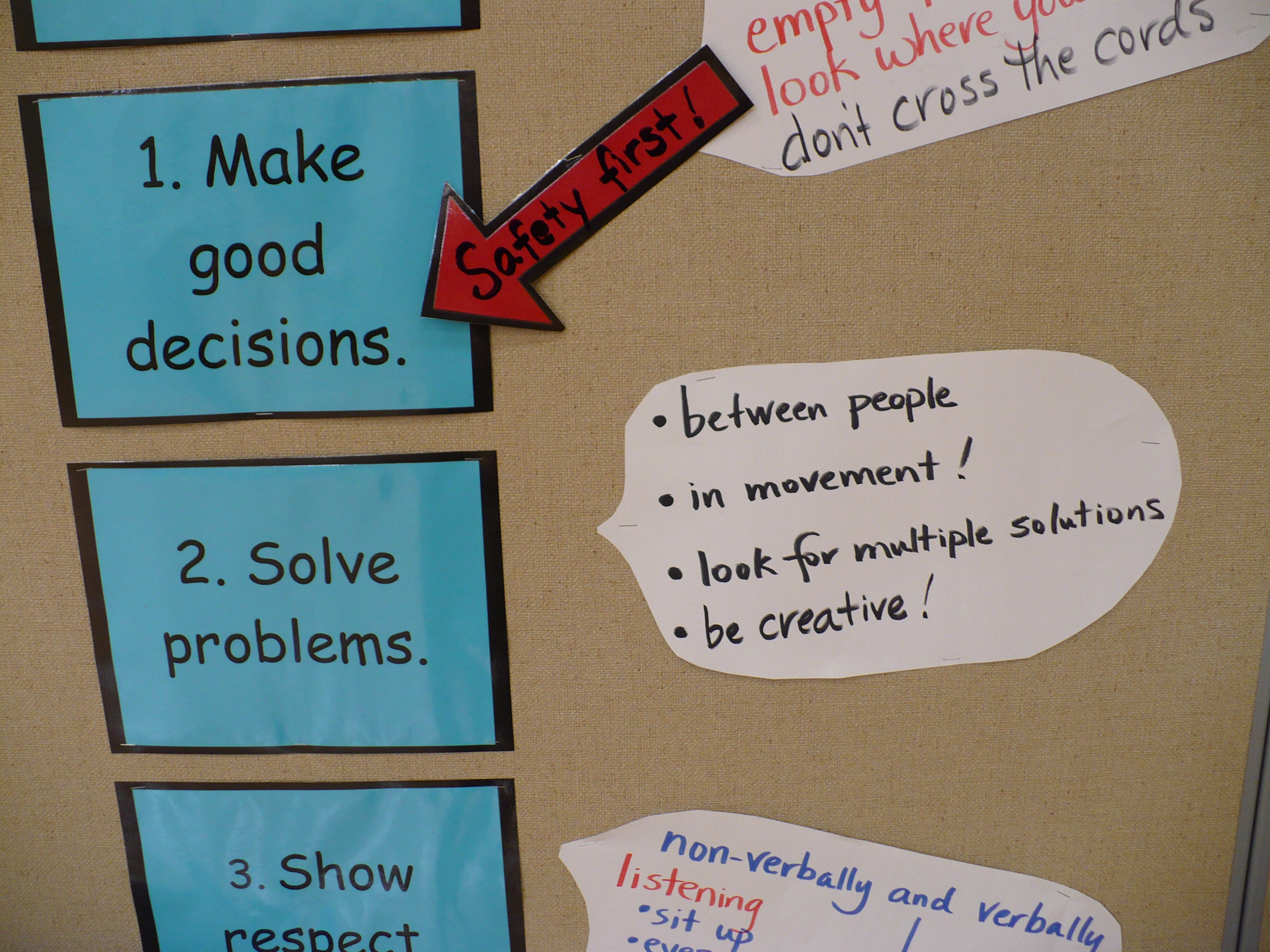
Details for "Solve Problems"
Lesson 4: Emergency Drill procedures have to be inserted somewhere during the first week. Cover them, practice them & then repeat whatever dance structure was most fun & successful — the one they’re asking for!
An aside: As the year begins, safety & management guidelines are the first priority. I teach students from kindergarten through 5th grade, so many have already been with me. However, every class has kids who are totally new to the school & dance, so expectations need to be clearly stated. By using word cards, it’s easy & quick to get moving, I can assess locomotor/nonlocomotor ability, the kids are doing the choosing, & choreograhy — making up their own sequences & dances — starts right away.
Another note from my sister on the subject of John Ratey & his work:
“I just came back from a talk by Harvard psychiatrist John Ratey on the relationship between exercise and learning. His final comment in the presentation, during the question and answer period, was this: “I think dance is the ultimate best exercise.” [John Ratey, M.D., 10/1/09, Drake Center, Fort Collins, CO] He indicated that he thought this because dance combines physical with intellectual engagement.”
It’s probably coincidental that John Ratey’s book on the benefits of exercise is called Spark: The Revolutionary New Science of Exercise and the Brain. It’s on my to-read list, but meanwhile its title — and John Ratey’s quote about dance as the ultimate exercise — remind me of Sparks of Genius: The 13 Thinking Tools of the World’s Most Creative People by Robert & Michele Root-Bernstein. Sparks of Genius is a book I’ve referenced often while trying to elucidate the kinesthetic intelligence for pre-service teachers in a graduate level summer course I teach.
In Sparks of Genius, the Root-Bernsteins explore the territory of how creative people get & nurture their ideas. By exploring journals, letters, reports & memoirs from eminent thinkers, creators & inventors (the likes of Albert Einstein, Arthur C. Clarke, Pablo Picasso & Helen Keller), the authors identified “a common set of thinking tools at the heart of creative understanding:” observing, imaging, abstracting, recognizing patterns, forming patterns, analogizing, body thinking, emphathizing, dimensional thinking, modeling, playing, transforming, and synthesizing. Creative thinkers have their preferred methods from among this list, and each tool can come to life in its own way. Nonetheless, I have this list posted next to my desk in the classroom because every one of the 13 thinking tools occurs with frequency in a dance class.
… thoughts sparked by John Ratey’s reported comment that dance is the ultimate best exercise. And by way of clarifying the depth to which dance combines physical with intellectual engagement. Dance does pack a whollop.
One of my wonderful 5th graders said to me once, “Make your day dance!” …and captured the essence of dance as a transformative experience. Watch this little clip, and transform yourself with a smile…
Comments Off
My sister sent a reference to SPARK, a book written by Dr. John Ratey of Harvard Medical School & filled with case studies exploring the connection between exercise and the brain. It tells those of us who teach dance what we already know. But given the current trends in education, there are a lot of people who haven’t gotten the message. Add this one to your arsenal of research & support!
And…
Rule #1 of John Medina’s BRAIN RULES, a book about how the brain works, is “Exercise boosts brain power.” I’m so glad there are people doing research & collecting data, cause I’m too busy counting dance combinations out loud for 180 kids a day to quantify results!
Do you have more wonderful research? Please share!